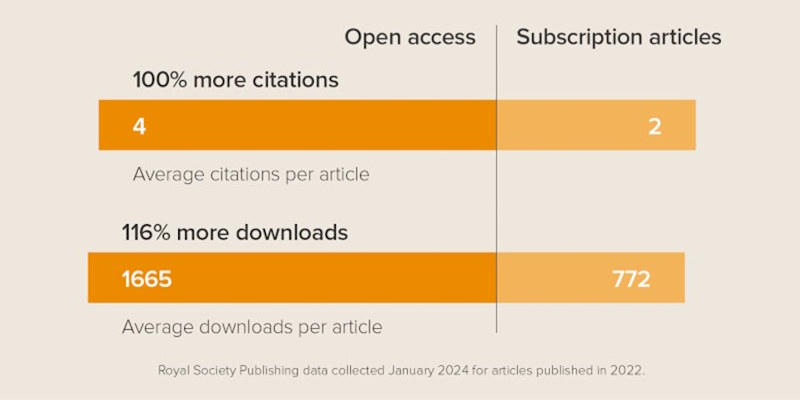We look back on the impact of the Royal Society Open Access Equity scheme’s first year, and speak with one of our authors about their experience.

Open access publication increases the reach and dissemination of scientific work. Data from Royal Society journal articles published in 2022 shows that papers published open access receive 100% more citations and 116% more downloads. So why should this be restricted to authors by funding, or institutional, national or international structures?

Data from the Royal Society hybrid journals show that, for articles published in 2022, open access papers received 100% more citations and 116% more downloads.
Last year, we formalised our support for global open access publishing through the establishment of the Royal Society Open Access Equity scheme. This offers free publication to researchers from over 100 low- and middle-income countries and territories on all our journals, sharing these benefits of dissemination and reach.
The impact so far
In the year following implementation on 31 July 2023, we have seen this scheme support 20 papers to publication. Author location was extremely varied, with 14 countries represented across 4 different continents. This diversity was reflected in the disciplines of the work too, which included applied mathematics, nanotechnology, environmental chemistry, computer science, ecology and conservation, and more. By a small margin, the majority fell within the physical sciences.

Of the 20 articles published through the Royal Society Open Access Equity scheme since launch, author geographic origin was spread over 4 continents – 7 from Africa, 7 from Asia, 4 from Europe and 2 from South America.
An author’s experience
We spoke with Dr Yannick Baidai, Environment and Fisheries Resources Specialist with African Marine Enterprises, Côte d’Ivoire, about his paper, Direct assessment of tropical tuna abundance from their associative behaviour around floating objects, which was published in Proceedings B in August 2024.
• Can you tell us a bit about the work presented in your article? Did you have any surprising findings?
My work takes place in the context of the tropical tuna fishery, which is facing the challenge of finding alternative methods to improve stock assessment and the subsequent management measures. Tropical tunas, like many pelagic fish, are known for their associative behaviour with floating objects found at sea. Although the underlying causes of this behaviour are not yet fully understood, it has been exploited for decades to increase catches in industrial purse seine fishing. However, the intensive use of floating objects, specially designed to attract tuna and known as fish aggregating devices (FADs), has led to controversy over the sustainability of the exploitation of stocks. One of the interesting aspects of our approach lies in the exploitation of this specific behavioural trait to provide direct estimates of tuna abundance. This is all the more amusing given that FADs themselves represent one of the major innovation in tropical tuna fisheries, which has introduced significant uncertainties into traditional methods of estimating tuna abundance based on purse seine catch and effort data.
• Was it important to you that your article was published open access? Why?
As tunas are only a case study of the approach, which can be applied to any species exhibiting associative behaviour with aggregation sites, open access publication offers a wider audience, including researchers, practitioners and policy makers, particularly from African countries such as mine, who generally have limited access to subscription-based journals.
• How did you find your experience of publishing with Proceedings B?
There's only one word to describe it: PERFECT! From the initial submission, to the review process and publication, everything was smooth, clear, transparent, and above all fast and responsive. I really enjoyed my experience of publishing in a journal like Proceedings B.

Schooling yellowfin tuna, Thunnus albacares. Credit: Wikimedia Commons.
What is to come?
Open access addresses many disparity issues for readers, allowing those without subscriptions to read, engage with and build on the latest peer-reviewed science published in journals. It’s a foundational pillar of the open science movement, required by many institutions and funders. However, a layer of complexity is added when considering financial models, as article processing charges and publication fees can easily introduce an unfair disparity in authors’ choice when it comes to reader access of their article. The world of scientific communication and publishing is evolving rapidly, and while there are many avenues and possibilities, we hope to continue taking steps to move towards a fair and barrier-free future.
We look forward to seeing what the next year brings for Royal Society Open Access Equity. If you have any questions for our team, don’t hesitate to get in touch with us at publishing@royalsociety.org.
Image 1: The world from space, centred over the African continent. Credit: seruvenci.
Image 2: Data from the Royal Society hybrid journals show that, for articles published in 2022, open access papers received 100% more citations and 116% more downloads.
Image 3: Authors of papers published through RSOAE were geographically diverse.
Image 4: Schooling yellowfin tuna, Thunnus albacares. Credit: Wikimedia Commons.
